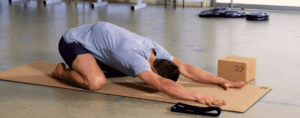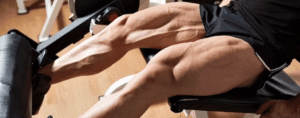Many people suffer from lower back pain that spreads to the legs and feet. This can often be overcome with deep Piriformis stretches – stretches that release tight piriform muscles and relax the sciatic nerves.
The muscular constriction of the piriformis can interfere with the sciatic nerve as they are close to each other. By irritating the sciatic nerve, the result is pain (either in the lower back or thigh), numbness and tingling along the back of the foot and inside the foot.
What is the Piriformis?
The piriformis muscle is a small muscle located in the buttocks, behind the gluteus maximus. It connects the spine to the top of the femur and allows exceptional flexibility in the hip region (it is the main muscle that allows movement outside the body of the hips, legs and legs).

The sciatic nerve passes under this muscle route to the posterior thigh. However, in some people the sciatic nerve can pass directly through the muscles, causing sciatic symptoms caused by a condition known as piriformis syndrome.
Unfortunately, for many people, their sciatic nerve goes through the piriformis muscle, which causes them to experience pain that will not go away (as well as poor mobility and balance).
Causes of Piriformis syndrome
The exact cause of piriformis syndrome is unknown. The truth is that many health professionals cannot determine the cause, so they really cannot diagnose it. Even with modern imaging techniques, the piriformis is difficult to recognize.
Lower Back pain caused by the affected piriformis muscles represents 6 to 8% of those who suffer from back pain
Suspected causes of Piriformis syndrome include:
- Tightening of the muscles, in response to an injury or spasms.
- Swelling of the piriformis muscle due to an injury or spasm.
- Irritation of the piriformis muscle itself.
- Irritations in neighboring structures such as the sacroiliac joints or hip.
- Bleeding in the piriformis area.
All of the above can affect the piriformis muscle, as well as the adjacent sciatic nerve.
In addition, piriformis that are not parallel or inflamed can cause difficulty and pain when sitting and changing (from sitting to standing). I really did lie too far in a yoga pose once and it upset my piriformis muscles.
It took me 1-2 years to fully heal. I suffer from pain when sitting and change from sitting to standing position. I remember it was a big pain in the ass (sorry bread), but I ended up with stretching and triggering the release point and it finally disappeared.
Also Read: How to Get Relief from Sciatica Pain?
10 Deep Piriformis Stretches
This piriform section is ideal for reducing pain and triggering the sciatic nerve.
It is also important to note that excessive stretching can make the condition worse. The light and smooth stretch is the best. I stretch my piriformis and that ignites it for 1-2 years (because I always do yoga every day and I do too much stretching).
Make sure to warm up your muscles before stretching your body, as you can create different sores. To warm up, just walk or line up on the spot or go up and down the stairs slowly for several minutes before stretching.
The exercise and stretching of Piriformis is very valuable; now try these 10 stretches:
1) Supine Piriformis Stretch

- Flat your feet and lie on your back.
- Pull the affected leg toward the chest, hold the knee with the hand on the same side of the body and reach the ankle with the other hand.
- Pull the knee toward the opposite shoulder until you feel the stretch.
- Hold for 30 seconds, then slowly return to the starting position.
There are many variations of this stretch, but here is a good video to show:
2) Piriformis foot stretch

- If you have difficulty balancing, stand with your back to the wall and move forward 24 inches. Put your knee on your ankle, then lower your hip 45 degrees to the floor.
- Lift your right foot off the ground and place the outside of your right wrist on your left knee.
- Lean forward and lower your chest to your knees while keeping your back straight. 4. Stop when you feel curved stretches. 5. Hold for 40-60 seconds, then switch legs and repeat again.
3) Piriform Outer Hip Stretch

- Bend your right knee.
- Use your left hand to pull the knee to the left. Keep your back to the ground and when you do, you should feel stretched in your hips and buttocks.
- Hold 20-30 seconds and repeat on the other side.
4) Long Adductor Stretch

- Sit on the floor, stretch your legs as far as possible.
- Lean your upper body slightly forward on your hips and place your hands side by side on the floor.
- Lean forward and place your elbows on the floor if you can. You will feel a pelvic stretch.
- Hold 10-20 seconds and release.
5) Short thigh stretch (inner thigh)

- For this exercise, sit on the floor and assemble your feet.
- Use your elbow to apply downward pressure on the knee to increase the stretch.
- You should feel a stretch on the inside of your thigh. For deeper stretches, bend your upper body forward with your back straight.
- Hold 30 seconds, release and move your feet to the same position for 30 seconds.
6) Lateral Grip Exercise

- Lie on your side, your hips needing help.
- Bend your knees and position yourself forward so that your feet are parallel to your spine. 3. Make sure your upper hips are directly over each other and your back is straight.
- Keep the ankles together, lift the top of the knee from below. Do not move your back and do not tilt your pelvis when you do, otherwise the movement does not come from the hips.
- Return back the knee to the starting position again. Repeat 15 times.
7) Hip Extension Exercises

- Get on all fours with your shoulders directly on your hands. Modify the weight of your foot slightly to be able to work.
- Keep your knees bent, lift your knees off the ground so that your feet move towards the ceiling.
- Slowly lower your foot, return almost to the starting position and repeat 15 times.
8) Piriformis Lateral Stretch in the supine position

- Lie flat on the floor with your feet flat and lift your aching legs by placing your feet on the floor off the opposite knee.
- Pull the bent knee to the right center of the body with the opposite hand or towel until you feel the stretch. Do not force anything and be gentle.
- Hold the Piriformis stretch for 30 seconds, then return to the starting position and to the foot of the switch.
- Aim for total repetition 3.
9) Buttock Stretching for Piriformis Muscles

- Lay your stomach on the floor, place the affected leg across and under the torso so that the knee is exposed to the outside.
- Extend the unaffected leg directly behind the body and keep the pelvis straight. 3. Keep the sore leg in place, move your hips toward the floor and lean forward on your forearms until you feel deeply.
- Hold for 30 seconds, then slowly return to the starting position. Aim for a total of 3 sections.
10) Sitting stretch

- While seated, cross your right leg over the left knee.
- Lean forward slightly, making sure to keep your back straight.
- Hold 3-60 seconds and repeat on the other side.
Author Bio: I am Wendy Whitfield, a senior Gynecologist at Back Pain Chairs Lab, Chicago, Illinois, USA. We serve to American community about their better life and fruitful tips regarding daily routine.











Great post. I used to be checking constantly this blog and
I am impressed! Extremely helpful info specifically the ultimate section 🙂
I deal with such info a lot. I was looking for this particular info for a long time.
Thank you and best of luck.
I used to be suggested this blog by my cousin. I’m now not sure whether
this submit is written by him as nobody else recognize such exact approximately my trouble.
You’re incredible! Thanks!
I’m truly enjoying the design and layout of your website.
It’s a very easy on the eyes which makes it much more pleasant for me to come here and
visit more often. Did you hire out a designer to create your
theme? Superb work!
Do you have a spam issue on this website; I also am a blogger, and I was curious about your situation;
many of us have created some nice practices and we are looking to exchange solutions with other folks,
please shoot me an e-mail if interested.
https://ww1.prediksioni.sbs/
Hello There. I found your blog using msn. That is
a very neatly written article. I’ll make sure to bookmark it and come back to read more of your useful info.
Thanks for the post. I’ll definitely return.
Attractive section of content. I just stumbled upon your weblog and in accession capital to assert that I acquire actually enjoyed account your blog posts.
Any way I’ll be subscribing to your feeds and even I achievement you access consistently fast.
Hmm is anyone else encountering problems with the pictures on this blog loading?
I’m trying to find out if its a problem on my end or if it’s the blog.
Any feed-back would be greatly appreciated.
I’m not that much of a internet reader to be honest but
your blogs really nice, keep it up! I’ll go ahead and bookmark your website to come back later
on. All the best
https://resultogel.net/
Selamat datang di E2BET Indonesia – Kemenangan Anda, Dibayar Sepenuhnya.
Nikmati bonus menarik, mainkan permainan seru, dan rasakan pengalaman taruhan online yang adil dan nyaman. Daftar sekarang!
https://e2betportal.com/id/